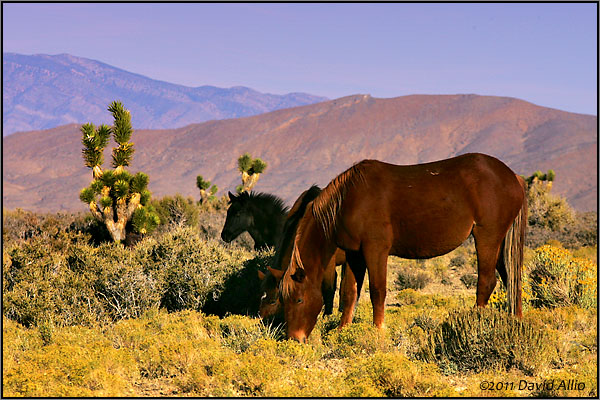When the term “Wild Horses” Equus ferus is mentioned, the common visual involves running herds of wild mustang. But there are other, colorful pastoral scenes, of wild horses and burros grazing in and near the harsh Mojave Desert.
Although cautious of people in their territory, these nearly half-ton creatures have been known to frequently approach visitors. These horses colored as pintos, blacks, cremellos, palominos, bays, browns, and sorrels may appear calm, docile, and even tame as they forage for food. But, they are still animals inhabiting a wild and extreme environment.

Wild Horses of Cold Creek | ©2011 David Allio
The wild horses and burros of Cold Creek have a lineage that can be traced back to regional ranching and settlement days. Most wild horses resemble Draft horses, Quarterhorses, Morgans, Thoroughbreds, and Standardbreds.
Two US government agencies oversee the management of this land and the inhabitants. These are the Bureau of Land Management (BLM) and the Forest Service (USFS). Based on their statistics, the area designated as the Spring Mountain Wild Horse Territory and the Wheeler Pass Herd Management Area is approximately 273,000 acres and, as of 2011, has about 273-328 wild horses and 101-152 wild burros.
Not everything in the desert is edible, let alone nutritious, or colorful. But in that desert area, there are five main plants – desert needlesgrass, indian ricegrass, big galleta, winterfat, and white bursage – supporting the wild horse population. These food sources are impacted by weather and wildfires. Water is also a concern. Food sources and water are not always close to the other. As a result, herds are constantly moving across the desert.
Despite hardships, both government officials and local observers agree that the herds of wild horses in this area are growing. Yet, they tend to disagree on the best ways to manage and interact with these nomadic animals.
Professional wildlife photographers have been known to return to the same locations for years, researching their subjects, habitat, and environment. They study and wait, preparing with the proper camera and lens combinations for timing to present an idyllic scene. Dedication to meticulous research leads to opportunities for an incredible, sometimes once-in-a-lifetime, image.
Photojournalists rarely have that luxury as they document scenes constantly subjected to compelling time constraints and relentless deadlines. They have to be quick studies, evaluating the safety of their surroundings before the production process even begins. Then quick, experienced decisions influence composition and accuracy in site representation.
For this illustration, my first experience with wild horses, the photographic production considerations included: camera and lens selection, followed by depth of field considerations – depth of field because of the distance involved between the camera, subject and background. Depth of field determines the f/stop range. The f/stop then dominates the exposure formula for film speed and shutter speed. For this image, a 200mm lens was selected. The other Manual Mode settings were: f/10 with a shutter speed of 1/1250th of a second using an ISO setting of 200.
Thank you to Krystal Johnson, the Wild Horse and Burro Specialist of the Southern Nevada District/Pahrump Field Office of the United States Bureau of Land Management, for providing the research information contained in this narrative.